|
EERS Equipment Service
|
|
To the right you see a CMI BioGrind horizontal grinder with the feed wheel
in the maintenance position. The horizontal conveyor belt brings the waste
to the feed wheel or rotor which pushes it into the mill. Hydraulic motors
drive both the conveyor belt and the feed wheel. You can see the end of the
discharge conveyor below the mill, which carries the ground up material to
a pile. The hydraulic systems are all powered by a Cummins diesel engine.
|
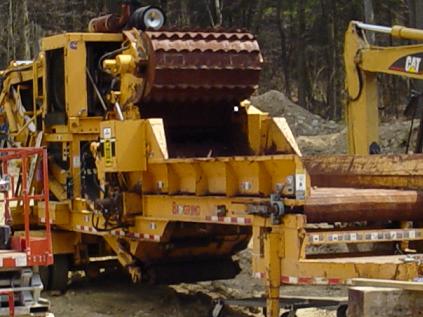
|

|
To the left is the top view of the mill in a CBI GrindAll 5060 suspended
by chains for bearing service. The bearings are accessed from the sides,
and need regular maintenance and greasing, or they'll suffer premature bearing
failure in these difficult environments. In this instance, the bearings failed
completely and needed to be replaced with factory new bearings. Under normal
operation, the mill spins at around 800 RPM and the teeth shred the material
until it is small enough to pass through the screen being used. Tub grinders
use direct drives for the mill, turning as fast as 2100 RPM, and are ideal
for woody type waste, smaller brush, in high volume operations. Tub grinders
are frequently used in landfills, industrial bulk waste reduction applications,
and even inner city botanical gardens.
|
|
To the right is the hammer mill for a grinder which was removed to rebuild
the tooth holding blocks and teeth. If you don't maintain the cutting edges,
or grinder tips on teeth, the cutters may wear away and the tooth holder
can then be damaged to the point that they need to be replaced. The holding
blocks need to be welded to the drum mill with a special stainless steel
MIG wire, or they may end up flying off the first time you crank up the mill.
By replacing the tooth tips as they wear, your grinder will perform better
and you'll be saved a costly rebuild. With the hammer mill on blocks, you
can also see the main mill bearings with a four bolt cap. On the other end
of the hammer mill, you can see the pulley for the belt drive. With large
belts costing a couple thousand dollars, it's worth keeping the teeth sharp
and reducing the chances of frequent jams. Replacing in time only costs from
$10 to $20 per tooth (parts, not labor) so it's well worth keeping up.
|
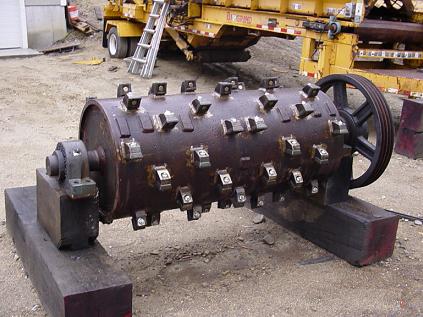
|
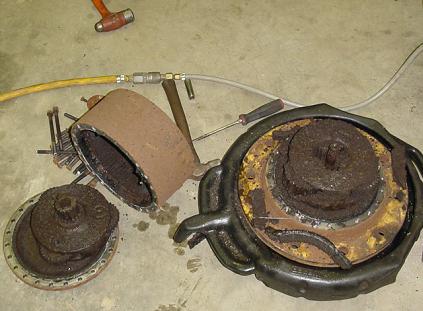
|
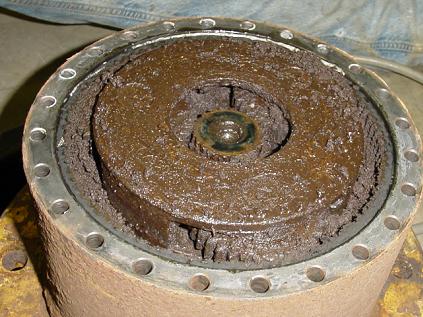
|

|
Above you see the results of the not maintaining a CMI Megagrind grinder.
The oil in the gear box for the feeder wheel was not changed on schedule,
if ever, and the resulting sludge achieved a cake like consistency until
the feeder wheel was completely jammed and could not advance the material.
The bearings went bad, gears were caked with rust, and parts are difficult
to find for specialized equipment which often goes out of production after
limited runs. Some other equipment serviced includes Morbark Chippers and
Peterson Pacific and Vermeer grinders. Environmental Equipment Repair Services
(EERS) can completely rebuild tub grinders, horizontal grinders, and other
bulk reduction equipment, either on your site or at their shop. Tub grinder
repair is usually carried out on the customer site due to the size of these
machines. EERS is located in Hardwick Massachusetts and travels through New
England and Eastern New York. For quotes, contact Mike Dougan at 413-477-0225.
|
|
Above is shown the central shaft of a Gruendler grinder mill which has warped
through improper operation - namely throwing a piece of steel several inches
thick into the feeder. The Gruendler grinder uses grid electric rather than
diesel power to generate 1200 horsepower with two 600 hp electric motors.
Proper maintenance is critical on a large grinder like this, where the bearings
alone can cost tens of thousands of dollars to replace. To the right you
can see the grinder mill disassembled into it's component plates. The hammers
are affixed to shafts running through all of the plates, with replaceable
teeth. The plates in this instance were cracked and also needed to be replaced.
|
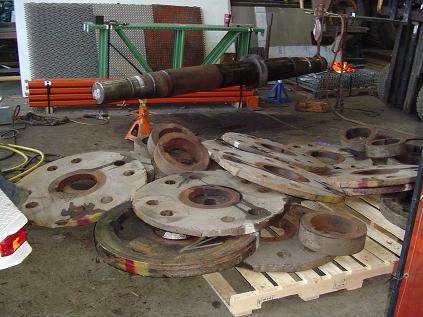
|
|

